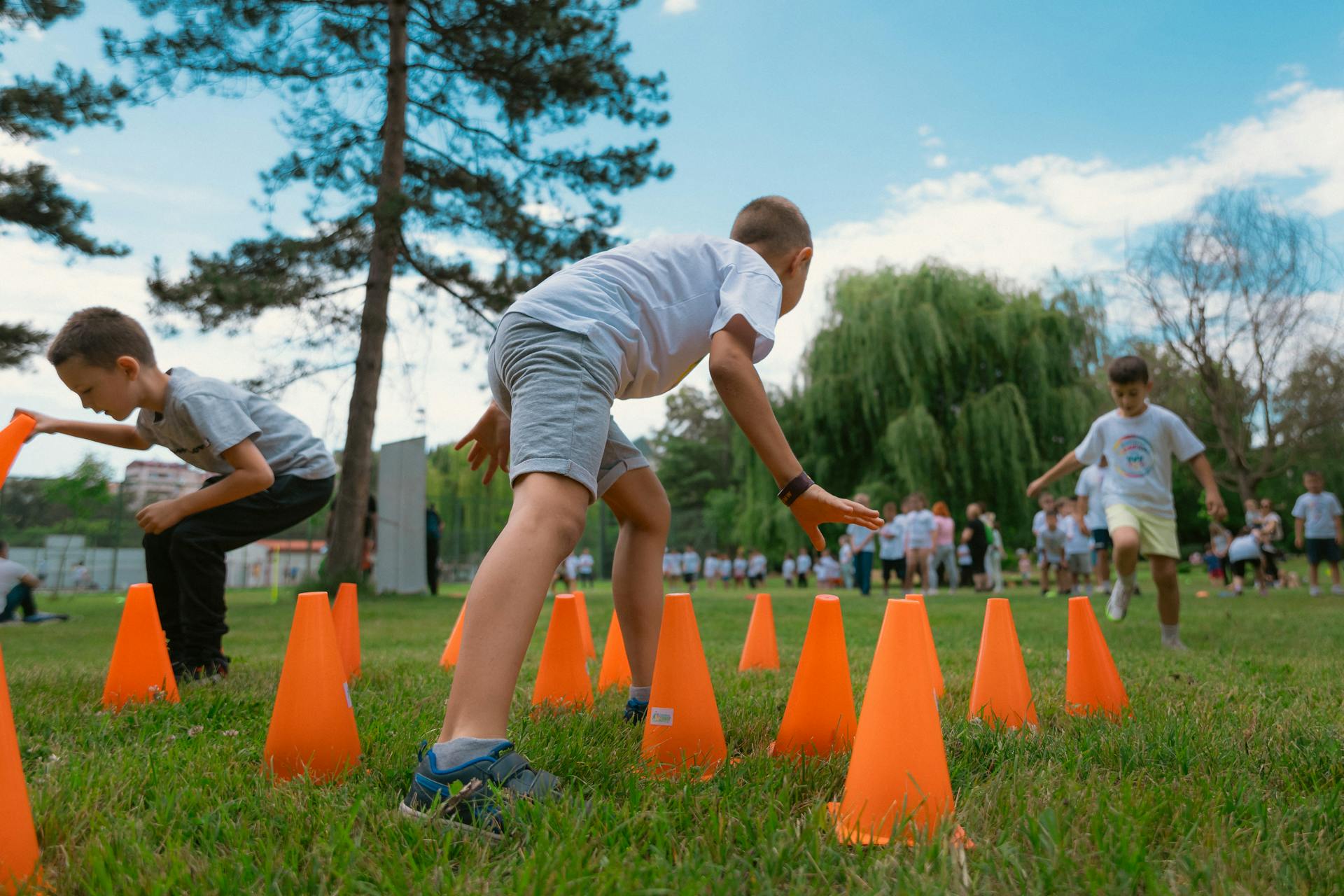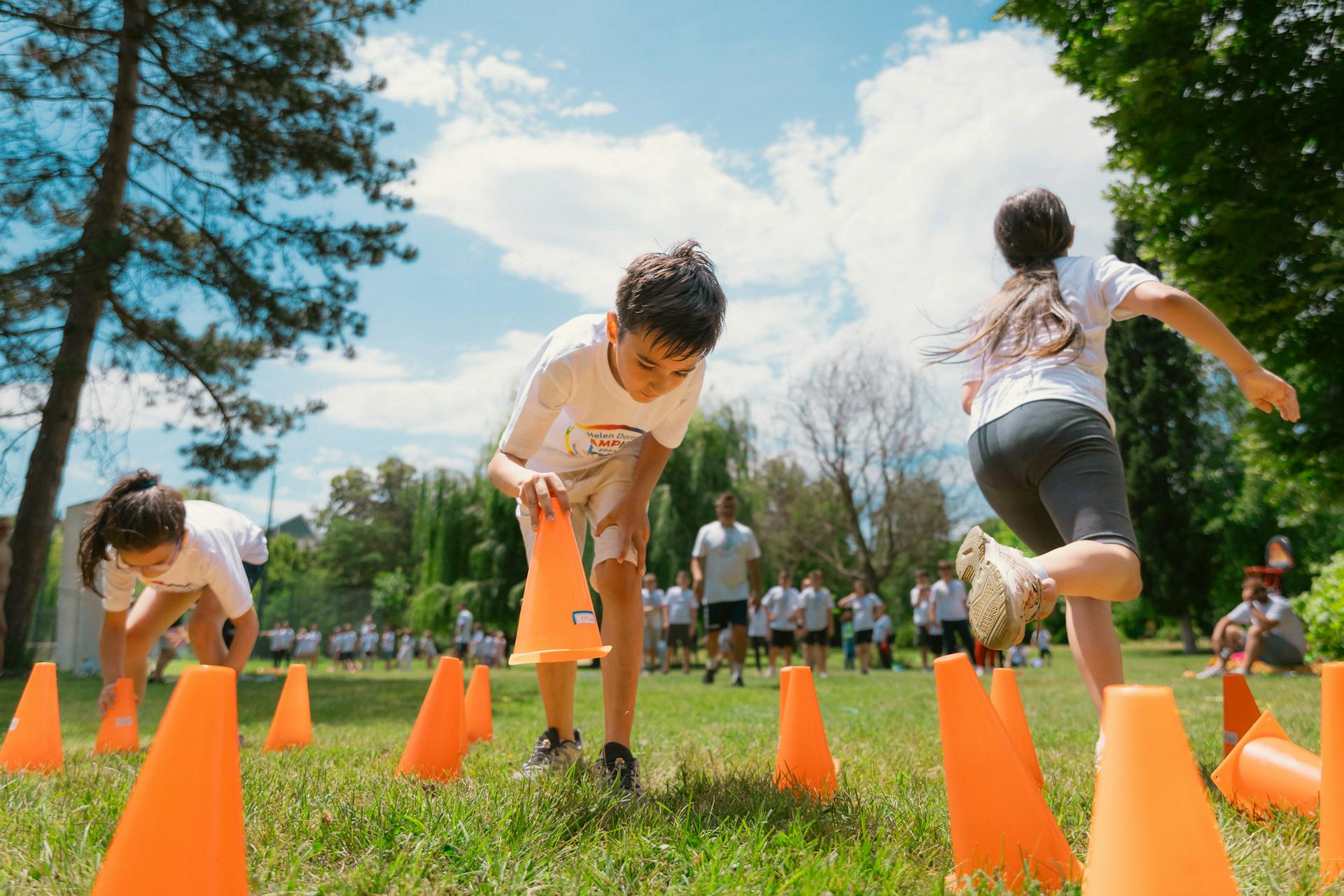
Proofing dog training is a crucial step in solidifying the skills your dog has learned. It's the process of exposing your dog to various distractions and environments to ensure they can perform the desired behaviors in a variety of situations.
Consistency is key when proofing dog training. This means setting up a routine and sticking to it, even on weekends and holidays. Consistency helps your dog understand what is expected of them.
The goal of proofing is to make the desired behaviors automatic, so your dog can perform them without thinking. This is achieved by gradually increasing the difficulty level of distractions and environments. For example, if your dog is trained to sit in a quiet room, you can then move on to proofing them in a busy park with other dogs and people around.
For your interest: Dog Distraction Training
Preparation
Preparation is key to successful proofing. To make proofing more effective, change only one variable at a time during training sessions.
It's essential to use higher-value treats, especially when introducing distractions. Lunchmeat, cheese, and peanut butter are popular choices that can keep your dog's attention.
Be realistic with your expectations and set your dog up for success. Failure to do a behavior is okay, but if it happens too many times, your dog might become frustrated. Go slowly and only increase the challenge once your dog can do a behavior correctly about 80% of the time in that particular scenario.
Here are some tips to consider when preparing for proofing:
- Make sure you're giving your dog a reasonable chance of success.
- Try to ensure your dog is calm before training sessions.
- Provide more exercise or mental stimulation during the day, perhaps with a puzzle feeder or a longer walk.
Remember, your dog's comfort and enjoyment should be your top priority. Use lots of tasty treats and praise to make training a fun and positive experience.
Teaching Basics
Teaching your dog to stay is a valuable aspect of dog training, giving a clear command that requires the dog to maintain its position until released.
This activity reinforces obedience and promotes safety. Puppies can start learning the stay command as early as eight weeks old.
Short, engaging training sessions are suitable for their developing attention spans. Consistent practice and supervision are key to success.
The time it takes can vary, but with daily sessions, many dogs can learn a reliable stay command within a few weeks. Consistency and gradually increasing the duration and distractions are crucial for the dog to master the command.
To teach the difference, one must be consistent in using each command for its specific context— "wait" to pause briefly, "stay" for remaining in one spot until released.
Explore further: How Long Should Dog Training Sessions Be
Setting Up for Success
To set up for success in proofing dog training, it's essential to create a conducive environment free from distractions. Equip yourself with a collar and leash to maintain control, especially in the early stages of training.
Be realistic with your expectations and go slowly, staying relaxed, and only increasing the challenge once your dog can do a behavior correctly about 80% of the time in that particular scenario. This will help prevent frustration and ensure a successful training session.
Use higher-value treats, especially when introducing distractions, to keep your dog's attention. If you're not sure what treats your dog finds most enticing, experiment to see what they like best.
Setting Up for Success
To set up for success in dog training, it's essential to create a conducive environment. A quiet room with minimal distractions is ideal for the early stages of training.
Use a collar and leash to maintain control, especially when teaching a new behavior. This will help you keep your dog safe and focused.
Change one variable at a time when proofing a behavior to avoid overwhelming your dog. For example, if you're working on the "sit-stay" behavior, only increase the distance between you and your dog during that training session.
Use higher-value treats to keep your dog's attention, especially when introducing distractions. Treats like lunchmeat, cheese, and peanut butter are popular choices.
To set realistic expectations, remember that failure is okay, but repeated failure can lead to frustration. Aim for your dog to perform a behavior correctly about 80% of the time in a particular scenario before increasing the challenge.

Here are some things to consider when setting up for success:
By following these tips, you'll be well on your way to setting up for success in dog training.
Integrating with Other
Integrating with Other Training is crucial to your dog's overall obedience and responsiveness. Incorporating the stay command into their broader training repertoire can make a big difference.
To do this effectively, you'll want to use command sequences. This means training your dog to follow a series of commands in a specific order, which can help them learn to stay focused and obedient.
Training in varied locations is also essential. This means taking your dog to different places, such as parks, stores, and friends' homes, to help them learn to stay in different contexts.
Incorporating playtime into your training sessions can also be helpful. This can make learning fun and engaging for your dog, which can help them stay motivated and focused.
Here are some key integration tactics to try:
- Command Sequences:
- Training in Varied Locations:
- Incorporating Playtime:
By using these strategies consistently, you can help your dog learn to stay reliably amidst a multitude of distractions and within different contexts.
Balanced Approach

To set yourself up for success with dog training, it's essential to understand the importance of a balanced approach. A balanced training approach involves a combination of positive reinforcement and correction-based training methods.
This approach doesn't rely solely on punishment or negative reinforcement, but instead uses correction-based training in conjunction with positive reinforcement. By doing so, you'll be able to proof your dog's obedience commands more effectively.
Using a balanced training approach can help you achieve consistency in your dog's behavior, even in distracting situations. For instance, incorporating the stay command into your dog's broader training repertoire can enhance their overall obedience and responsiveness.
Here are some key tips for implementing a balanced training approach:
- Use command sequences to build on previous training.
- Train in varied locations to help your dog generalize their learning.
- Incorporate playtime to make training more engaging and fun.
By incorporating these strategies consistently, you'll be able to help your dog learn to stay reliably amidst a multitude of distractions and within different contexts. This will set you both up for success and make training a more enjoyable experience.
Reinforcing the Behavior
Reinforcing the behavior is a crucial step in proofing dog training. Consistent practice and reward-based positive reinforcement are key to ensuring your dog fully understands and obeys the command.
To reinforce the stay command, you'll want to practice with gradually increased separations between you and your dog. This is because the distance between you and your dog can make a cue more difficult, so practice with gradually increased separations.
The progression of practicing in different environments is also important. Here's a step-by-step guide to help you proof your dog's behavior:
Remember to practice with gradually increased separations and distractions, and only move on to the next step when your dog consistently responds in the current environment.
Frequently Asked Questions
What are the 3 D's of dog training?
The 3 D's of dog training are duration, distance, and distraction, which impact a dog's ability to generalize learned behaviors. Understanding these factors is crucial for effective dog training and communication.
Sources
- https://resources.bestfriends.org/article/dog-training-tips-how-proof-behaviors
- https://roguepetscience.com/blogs/dog-training/how-to-teach-a-dog-stay
- https://animalwellnessmagazine.com/behavior-proofing-training-dog/
- https://advancedcaninetechniques.com/2019/02/proofing-your-dogs-commands/
- https://suburban-k9.com/proofing-dog-obedience/
Featured Images: pexels.com


